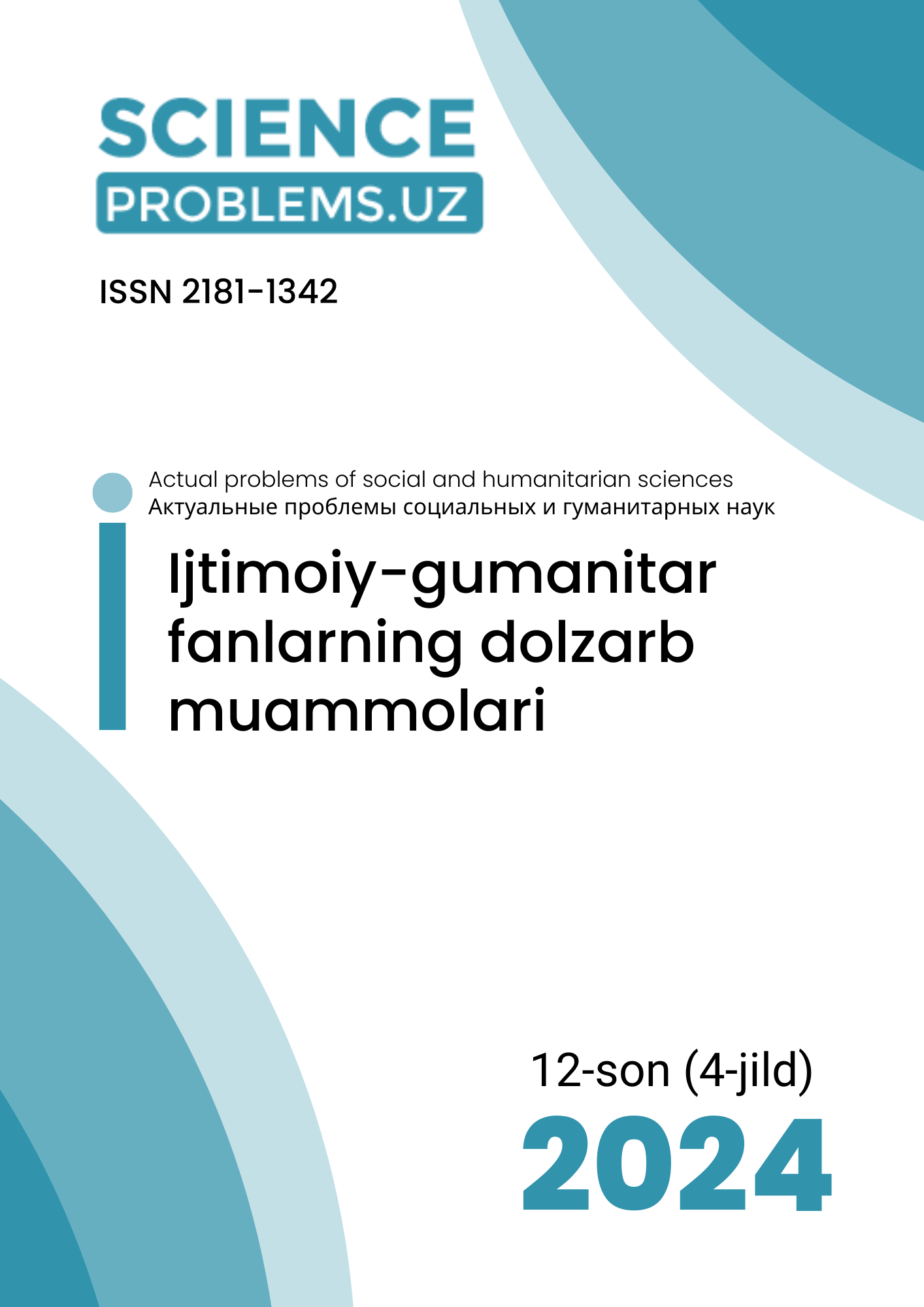PERSONAL NUMBER CATEGORY IN UZBEK AND ENGLISH LANGUAGES
DOI:
https://doi.org/10.47390/SPR1342V4I12Y2024N47Keywords:
person-number category, morphological analysis, functional-semantic, comparative analysis, english language, uzbek language, grammar.Abstract
This article focuses on the morphological analysis of the category of person and number in Uzbek and
English from a functional-semantic perspective. The author compares the grammatical systems of both languages
and provides a detailed analysis of their similarities and differences. The category of person and number is
examined not only as a grammatical marker but also as an essential element that reveals the functional-semantic
characteristics of the languages. In Uzbek, the category of person and number is closely linked to verb tense and
mood, reflecting the richness and complexity of the language's morphological system. Personal and numerical
affixes in Uzbek (e.g., -man, -san, -miz, -siz) are widely used, allowing the expression of person and number without
the necessity of personal pronouns. In English, the category of person and number appears only in one tense—
present simple—and is expressed by the -s ending, which is exclusively used in the third person singular
(he/she/it). In other tenses, person and number are conveyed through auxiliary verbs (to be, have, will/shall). The
author also emphasizes that, unlike Uzbek, the obligatory use of personal pronouns (I, you, he/she/it) in English
is a significant distinguishing feature. The article explores the following differences between the categories of
person and number in Uzbek and English:
Uzbek has a greater variety of personal and numerical affixes, whereas English has a minimal number of
such forms.
In Uzbek, personal affixes can attach not only to verbs but also to other parts of speech (nouns, pronouns,
adjectives), functioning as predicates. In English, such a phenomenon is almost absent.
In Uzbek, personal affixes are closely interconnected with tense and mood categories, while in English,
they are limited to the present tense.
English requires personal pronouns to explicitly indicate person and number, whereas in Uzbek, this is
often unnecessary, as the personal affixes already contain this information.
In conclusion, the author highlights the communicative significance of the person and number categories in both
languages through examples and analyzes their role in translation. This article presents a valuable scholarly
contribution for linguists and researchers studying the comparative aspects of Uzbek and English languages.
References
1. Friederike Moltmann. Plural Reference and Reference to a Plurality. Unity and Plurality.
Philosophy, Logic, and Semantics. Oxford, England: Oxford University Press, 2016. – 93-
120 p.
2. HouKa Chan, Hao Tan, Ruiqi Xiao. Research on the Effects of Plurality on Minds.
Proceedings of the 2022 6th International Seminar on Education, Management and Social
Sciences, 2022. – 788-793 p.
3. Jabborova Aziza Jobirovna. The Category of Person in English Grammar. Modern Science
and Research, 2023. – 368-371 p.
4. Jillian Mcilwain, Peter Peterson. Signaling Plurality in Learner English. Proceedings of the
2004 Conference of the Australian Linguistic Society, 2005. – 1-9 p.
5. J.Buranov, U. Hashimov, H.Ismatullayev, Ingliz tili grammatikasi. O‘quv qo‘llanma. – T.,
“O‘qituvchi nashriyoti”, 1974. – 351 b.
6. J.Bo‘ronov. Ingliz va O‘zbek tillari qiyosiy grammatikasi. O‘quv qo‘llanma. – T., “O‘qituvchi
nashriyoti”, 1973. – 279 b.
7. Karimova Kamola Lutfullayevna. Tense, Person, Number in English Grammar.
O‘zbekistonda Fanlararo Innovatsiyalar va Ilmiy tadqiqotlar Jurnali, 2023. – 547 p.
8. Mohammed Jasim Betti. Grammatical Person and Number. Research Gate, 2022. – 19 p.
9. N.Turniyozov, A. Rahimov, O‘zbek tili. O‘quv – uslubiy qo‘llanma. - Samarqand. 2006. –
147 b.
10. R.Sayfullayeva, B.Mengliyev, G.Boqiyeva, M.Qurbonova, Z.Yunusova, M.Abuzalova.
Hozirgi O‘zbek adabiy tili. O‘quv qo‘llanma. – T., “Fan va texnologiya”, 2009. – 416 b.
11. Suzana Ejupi, Lindita Skenderi. Grammatical Categories of Verb in English and Albanian.
Knowledge International Journal, 2018. – 2245-2249 p.
12. Sh.Shoabdurahmonov, M.Asqarova, A.Xojiyev, I.Rasulov, X.Doniyorov. Hozirgi O‘zbek
adabiy tili I qism. – T., “O‘qituvchi”, 1980. – 443 b.
13. X.S.Muxitdinova., D.Xudoyberganova., I.Umirov., N.Jiyanova., T.Yusupova. Hozirgi O‘zbek
Adabiy Tili. O‘quv qo‘llanma. – T., “O‘qituvchi”, 2004. – 189 b.
Internet saytlari:
1. Articles: Singular vs. Plural | Edanz Learning Lab
2. https://www.aje.com/arc/editing-tip-singular-and-plural-forms-scientific-writing/
3. https://journals.openedition.org/acs/12386
4. https://www.unisa.ac.za/sites/corporate/default/Unisa-Open/OER-@-
Unisa/Linguistics/Grammatical-categories








